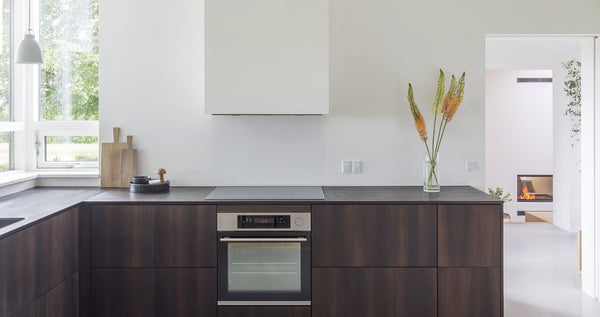We all love the kitchen room
... This is where we are with friends and family, and here we are talking about today's good and bad events over a good meal. But a kitchen room is not a tomato a nice place. There are really many things that you need to be aware of before it suits you and your daily life. Look here and avoid the biggest kitchen biscuits.

1. A kitchen room requires space
Look at the room you want to make your kitchen room. Is there room for your family's activities? A kitchen room typically houses not only a kitchen and a dining area, but often also a playroom, a workplace, and a television room. Plenty of drawers and shelves, as well as floor and table space, are important. Also for newspapers, toys, books, and the computer, if you want it or not, surely always end up there.

2. Decorate the kitchen in zones and with lanes
Think of zones and gangways when you create your kitchen room. In this way you avoid falling over toys and should pull your stomach in front of passers when you are steaming pickles. Place the washing machine and the coffee maker close to the dining area if you can quickly cover a table and clean after a meal. Consider whether your kitchen needs to be separated by a shield so you do not have to look at your dishes. If you have a garden or a balcony, it may be smart to make an exit from the kitchen. That way, it will be easier to carry the food out and you will use your outdoor space more.

3. Put the kitchen in the right light from the start
Lamps are typically the last thing you think about when you need a new kitchen. But light can do a lot for a room, also for your kitchen. You should, therefore, think about it from the start. A kitchen needs both good orientation lights, work lights over the kitchen table and nice lighting over the dining area. Think about choosing something that does not dazzle, create disturbing shadows or hangs too low. A typical mistake is to place the scented candle, so you shadow yourself when standing and chopping vegetables or stirring in the pan. The best way to work well is to place it on the underside of a cabinet. Here, it can light completely undisturbed.
Also, consider cutting your wires into the wall, now you are renovating. Then you will be free once to look at ugly dust collectors. At the same time, make sure you have plenty of electrical outlets so you do not have to wait for the coffee before shaking bread.

4. The kitchen should fit your habits
Where do you charge your mobile phone? Where do the children do homework? And where do you put your bag when you get home from work? When do you eat food? How many are you about making the food? And what food do you do? Should the spices stand ahead, or can they be stored away in a closet? Your kitchen room will suit your habits - and habits. Therefore, take note of your daily life and think of new needs, solutions, and habits in your kitchen. There must be room for it all, without the kitchen ending in chaos every day. Consider whether you would like TV and computers to have space in the room as it may cushion and reduce the amount of conversation and intercourse.

5. Invest in a good sigh
Food often smells nice, but it's rarest if the smell and the ozze stick to the kitchen. Therefore invest in a good hood with sufficient suction capacity. It is said that an extractor should be able to empty a room for air 10 to 20 times an hour. In a kitchen area of 35 m² it will require an extractor hood with a suction power of about 1000 m³. You can calculate how much suction power of your upcoming hood should be by squaring x x room height x 10 (the number of times the air must be changed in one hour). However, remember to add some extra engine power, as the hood's drain hose and any bumps steal some of the capacity.

6. Select the right materials
If you want to avoid too much cleaning and maintenance, you must go in a big bow without materials like calcareous natural stone, concrete, and wood. They will forever remind you of the oven baked beetroot, you lose a few of once - unless you are cleaning and maintenance. Instead, choose steel, linoleum or laminate for the kitchen and tiled floor tiles.

7. Avoid poor acoustics
Bad acoustics is the kitchen hall's Achilles heel. This is usually due to a combination of room size and unfortunate material selection. It is especially the hard materials, such as clinker and concrete, which distort the sound in the large and high-rise kitchens. But with a little care in the interior, it is possible to create a comfortable sound in the kitchen room. If you choose a concrete floor, for example, it's a good idea to compensate for an acoustic ceiling. Acoustic chords are available in many amazing designs, thus contributing to both the architecture and the sound in the room. You can also supplement with softer materials such as blankets, paintings, upholstered furniture, and curtains. In this house, designed by architect Rasmus Skaarup, there is a kitchen-room with a ceiling for a chicken and a sound-absorbing list ceiling.

8. Security above all
A lot of accidents at home take place in the kitchen. Here are sharp knives, boiling water and hot pans. And many also have little children who wants to help, touch it all and have their parents' full attention, even if they are eating vegetables.
But fortunately, there are plenty of things you can do to prevent accidents when you are setting up your kitchen.
- Put child locks on drawers and cabinets with dangerous things so the little arrow fingers do not even find it while you look the other way.
- Have plenty of floor space. This reduces the risk of collisions and other accidents in the corridors in the kitchen.
- Choose soft materials like wood and avoid sharp edges at children's height. Also, consider your flooring material. Klinker and natural stone are beautiful but can be very slippery if water is on. And if you lose a glass or a bowl, it will split immediately.
- Place the oven high, so it's harder for the children to reach and come to bed.
- Induction can save many burned children's fingers. With its magnetic effect, it can only be turned on if there is a pot on the hob.

9. The kitchen's Bermuda triangle
Fridge, hob, and sink are the three most used places in the kitchen. Therefore, make sure that the features function optimally, as it will make your work in the kitchen much easier. In fact, the location of these three functions is so important that they have been the center of study in the early 50's. Here it was found that if the distance becomes too small, the work and the movements will be too strained and hugging. If it becomes too large, it will feel like endless migrations between the three functions. The total distance must never be less than 360 cm. and never greater than 660. The distance between the sink and the cobblestone center is particularly important and well-attended and should, therefore, be between 120 and 180 cm.



